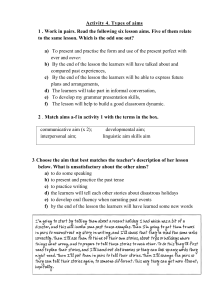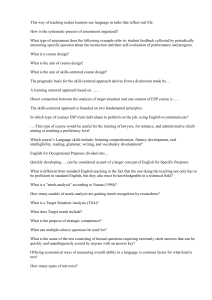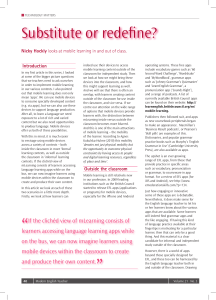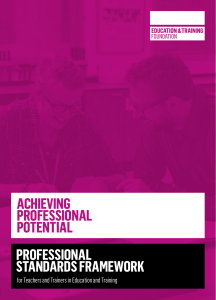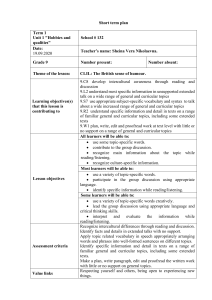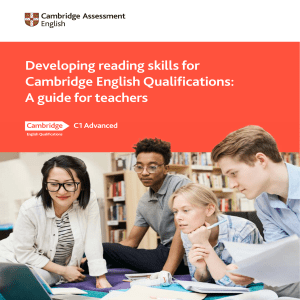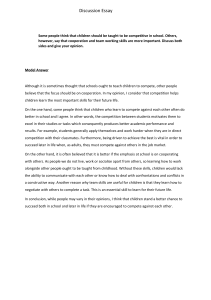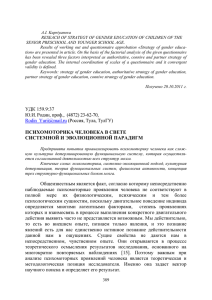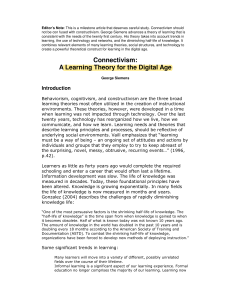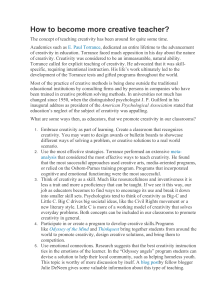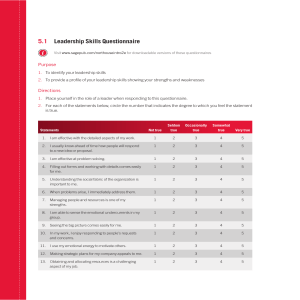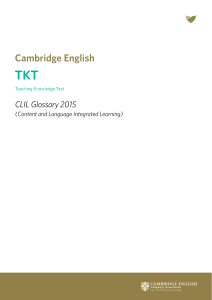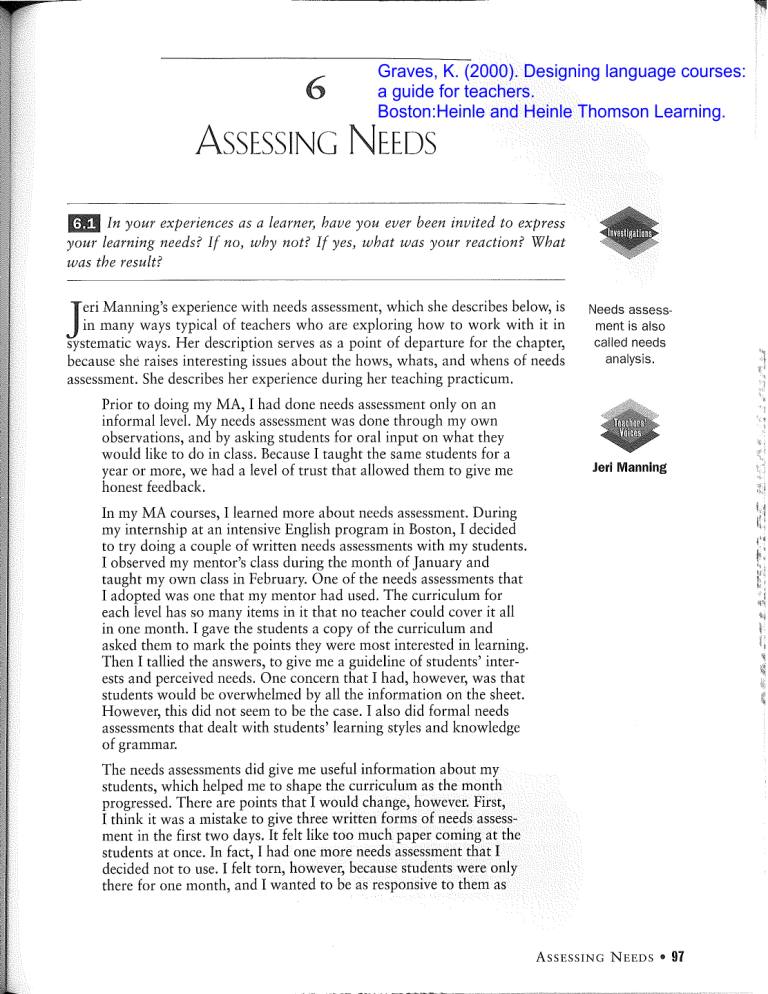
6 Graves, K. (2000). Designing language courses: a guide for teachers. Boston:Heinle and Heinle Thomson Learning. AssESSING NEEDS m In your experiences as a learner, have you ever been invited to express your learning needs? If no, why not? If yes, what was your reaction? What was the result? eri Manning's experience with needs assessment, which she describes below, is in many ways typical of teachers who are exploring how to work with it in systematic ways. Her description serves as a point of departure for the chapter, because she raises interesting issues about the hows, whats, and whens of needs assessment. She describes her experience during her teaching practicum. J Prior to doing my MA, I had done needs assessment only on an informal level. My needs assessment was done through my own observations, and by asking students for oral input on what they would like to do in class. Because I taught the same students for a year or more, we had a level of trust that allowed them to give me honest feedback. Needs assessment is also called needs analysis. Jeri Manning In my MA courses, I learned more about needs assessment. During my internship at an intensive English program in Boston, I decided to try doing a couple of written needs assessments with my students. I observed my mentor's class during the month of January and taught my own class in February. One of the needs assessments that I adopted was one that my mentor had used. The curriculum for each level has so many items in it that no teacher could cover it all in one month. I gave the students a copy of the curriculum and asked them to mark the points they were most interested in learning. Then I tallied the answers, to give me a guideline of students' interests and perceived needs. One concern that I had, however, was that students would be overwhelmed by all the information on the sheet. However, this did not seem to be the case. I also did formal needs assessments that dealt with students' learning styles and knowledge of grammar. The needs assessments did give me useful information about my students, which helped me to shape the curriculum as the month progressed. There are points that I would change, however. First, I think it was a mistake to give three written forms of needs assessment in the first two days. It felt like too much paper coming at the students at once. In fact, I had one more needs assessment that I decided not to use. I felt torn, however, because students were only there for one month, and I wanted to be as responsive to them as AssEssiNG NEEDs " 97 possible. If I had the course to do over, I would space the needs assessments out, relax, and rely on my observation skills more. Another change that I would make would be to integrate needs assessment into the lesson plan, so that it becomes an integral part of the lesson, rather than an interruption in the flow. By doing that, I would hope that in addition to making the class flow smoothly, students would feel more willing to give honest feedback, especially given that a month is not a lot of time for students to learn that you really do want their honest feedback. Essentially, I want to develop needs assessments that will be an effective use of class time for students and give me the information I need to structure an effective course. £m Write a short description of your experience with needs assessment as a teacher. What have you assessed? Did you get the information you wanted? What did you do with the information? Was your experience similar to Jeri Manning's? Then consider the course you are designing, redesigning, or adapting as you read through this book (See Chapter 1, Investigation 1.4). What questions do you have about needs assessment with respect to the course? Use the questions to guide you as you read the chapter. Jeri Manning's narrative touches on four important areas that we will explore in this chapter. The first is the role of needs assessment in the development of a course. The second is the areas of learning needs assessment addresses. The third is when one should do needs assessment The fourth is how teachers can do needs assessment in ways that students understand, that are a good use of students' and the teacher's time, and that give the teacher information that allows him or her to be responsive to students' needs. THE ROLE OF NEEDS ASSESSMENT IN THE DEVELOPMENT OF A COURSE Essentially, needs assessment is a systematic and ongoing process of gathering information about students' needs and preferences, interpreting the information, and then making course decisions based on the interpretation in order to meet the needs. It is an orientation toward the teaching learning process which views it as a dialogue between people: between the teacher and administrators, parents, other teachers; between the teacher and learners; among the learners. It is based on the belief that learning is not simply a matter of learners absorbing pre-selected knowledge the teacher gives them, but is a process in which learners-and others-can and should participate. It assumes that needs are multi-faceted and changeable. When needs assessment is used as an ongoing part of teaching, it helps the learners to reflect on their learning, to identify their needs, and to gain a sense of ownership and control of their learning. It establishes learning as a dialogue between the teacher and the learners and among the learners. 98 • DESIGNING LANGUAGE COURSES: A GUIDE FOR TEACHERS Derica Griffiths expresses such a view of her needs assessment questionnaire for high school ESL students in a content-based history class: ... I use this.[ questionnaire] to convey to the students that I do care about them as individuals, and they do have a role and voice in the class. I feel the questionnaire is my first attempt to facilitate them in the expression of their voice. This is important to me as a teacher because I feel that a class is a community and as such, should be inclusive of all voices and opinions. Derica Griffiths eeing needs assessment as a form of dialogue is not the way I originally understood it. My first encounter with needs assessment as a formal undertaking was reading through Munby's 1978 book, Communicative Syllabus Design, in which he outlined numerous and detailed specifications for determining learners' needs. I was teaching English in Japan at the time, primarily to Japanese employees of a US-Japanese joint venture company. As a language teacher, I wondered how I would ever be able to get so much information, and if I could, what I would do with it. The lists and level of detail scared me off. In fact, had I known then what I know now about needs assessment, I believe I could have designed and taught a more focused and responsive course. Some years later, when I was writing the East West series, my co-authm~ David Rein, and I found the needs assessment inventories developed by the Council of Europe (VanEk 1986) for planning language programs to be an extremely useful tool in conceptualizing and organizing the content of the series. Needs assessment has been an important feature of ESP (English for Specific Purposes), EAP (English for Academic Purposes), and adult education courses. While much has been written about program needs assessment (e.g., Berwick 1989, Brindley 1989, Brown 1995), adult education has taken the lead in looking at needs assessment as part of teaching, not something done only prior to teaching (e.g., Burnaby 1989, Savage 1993). In my experience as a teacher and with teachers, for needs assessment to be meaningful at the course level, it needs to be understood as something that teachers can see and do as part of teaching. I remember a conversation with a teacher from Honduras to whom I had given a copy of David Nunan's Designing Tasks for the Communicative Classroom (1989). She came to my office in a state of panic. She used her hands to describe her feeling that the ground was shifting under her feet and she could no longer maintain her balance. The book suggested that she invite learners to give input into the design of activities, and she didn't see how this was possible or even a good idea. She mainly taught pre-teens and teenagers, so she had a point. But the conversation was really about a shift in her perception of the role of the learners and the teacher in the classroom. I think that needs assessment, as I have described it above, is one place in the development of a course in which a teacher must examine how she or he views the roles and power dynamic in the classroom. The teacher is not the only person who has views about the roles and power dynamic in the classroom or the needs of the learners. The students themselves will have expectations that may not include being asked to express their needs S ASSESSING NEEDS • 99 or to be partners in decision making. In fact, they may see it as clearly the teacher's role to make decisions about what to teach. If partnership and dialogue are at the root of one's view of needs assessment, then it must be done in such a way that students feel skillful in participating and see the value of it, both while doing it and in the results. Likewise, teachers need to learn how to feel skillful in conducting and responding to needs assessment. What can happen in the classroom is also affected and determined by the institution the class is a part of, and by other stakeholders, such as parents and ftmders, depending on the setting. Needs assessment can be as much about reconciling different views as about finding out what the needs are. Berwick, for example, makes a distinction between "felt needs," those the learners have, and "perceived needs," the way the needs are viewed by the teacher, the institution and other stakeholders (1989, p. 55). Even when needs assessment only involves the teacher and learners it is still a complex undertaking because different learners within the same class usually have somewhat different needs. THE PROCESS OF NEEDS ASSESSMENT The process of needs assessment involves a set of decisions, actions, and reflections, that are cyclical in nature: 1. Deciding what information to gather and why 2. Deciding the best way to gather it: when, how and from whom 3. Gathering the information 3. Interpreting the information 4. Acting on the information II 5. Evaluating the effect and effectiveness of the action ,,I) 6. (back to 1) Deciding on further or new information to gather This process can be viewed as a cycle as depicted in Figure 6.1. Figure 6.1: The Needs Assessment Cycle 1. Decide what information to gather and why \ 6. Evaluate the effects 2. Decide when, from whom, of the action \ and 5. Act on it 3. Gather information ~rpretit~ 100 ° DESIGNING LANGUAGE COURSES: A iow to gather it GUIDE FOR TEACHERS The view of needs assessment as a process of gathering information and interpreting it is very close to Kathi Bailey's definition of assessment in her book in this series, Learning About Language Assessment (1998, p.2). She writes, "The main purpose of language assessment is to help us gain the information we need about our students' abilities and to do so in a manner that is appropriate, consistent, and conducive to learning." Needs assessment and language assessment overlap when needs assessment is concerned with assessment of language ability, as in assessing proficiency at the start of a course, or when diagnosing language needs as part of ongoing needs assessment. Needs assessment also overlaps with course evaluation when it gathers information about how the way the course has been designed and is being conducted is or is not meeting the needs of the students so that unmet needs can be addressed. In Chapter 10, we will focus on designing an overall assessment plan for the course, which includes needs assessment, assessment of learning, and course evaluation. WHAT AREAS OF LEARNING DOES NEEDS ASSESSMENT ADDRESS? In the cycle in Figure 6.1, the first step is deciding what information to gather. When designing and teaching a course to meet students' needs, we assume that there is a gap to be bridged between a current state and a desired one, or progress to be made toward a desired goal, or a change to be made. The purpose of the course is to bridge the gap or some part of it, to help students make progress or to effect the desired change. For a course to meet learners' needs it is necessary to gather information about both the current state of the learners, where they stand in terms of language ability, learning preferences, and the desired goals or change, and where they would like to be or what they want to achieve, change, and so on. The cycle in Figure 6.1 can be repeated throughout the course at various times, depending on what you-and the learners-want to know. Figure 6.2 below shows the relationship between the purpose of a course and the purpose of needs assessment. Figure 6.2: Basic Purpose of Needs Assessment Purpose of course: learners• abilities, attitudes, preferences before course -------to make------+ desired progress toward abilities /change outcome Purpose of needs assessment: to gather info~ J \_ about to _Lnnation about in order to make decisions about what will be taught, how it will be taught, and how it will be evaluated. AssESSING NEEDS • 101 OJ What information could you gather about your learners prior to or at the beginning of the course? What information could you gather about the desired learning or improvement the course is supposed to bring about? Who can you gather the information from? T he list below (Figure 6.3) outlines information that can be gathered for the left side of the chart in Figure 6.2, learners' abilities, attitudes, and preferences now; and the right side of the chart, desired abilities and/or change. Numbers 1 through 6 are a list of what learners bring to a course or program. Numbers 7 through 10 are a list of where they would like to be or what they want to make progress toward. As the course progresses, the information about the "present" will change as the learners make progress toward the "future." Information can be gathered about how the course is or is not meeting the needs negotiated, both in what is being taught and how it is being taught. Needs related to the "future" may also change as the course progresses. Figure 6.3: Types of Information that Can Be Gathered when Assessing Needs We can gather information about: The present: 1. Who the learners are 2. The learners' level of language proficiency 3. The learners' level of intercultural competence 4. Their interests 5. Their learning preferences 6. Their attitudes The future: 7. The learners' [or others involved] goals and expectations 8. The target contexts: situations, roles, topics, and content 9. Types of communicative skills they will need and tasks they will perform. 10. Language modalities they will use D) Before reading the information below, take a moment to look over the list in Figure 6.3. What information will each item yield and how might it be helpful in understanding and planning for students' needs? 102 8 DESIGNING LANGUAGE COURSES: A GUIDE FOR TEACHERS After reading about each type of information, make a preliminary list of the information you feel you would like to gather for the course you are designing. Information about the present 1. Who the learners are What is their age, gender, educational background, profession, nationality? Is it a multicultural or single culture group? What languages do they speak? This information can help provide the background for the remaining questions; for example, we will ask for or interpret information differently if the students are children or adults, literate in their first language or not, of mixed nationality or of one nationality. 2. The learners' level of language proficiency What is their level of proficiency in each of the four skills in the target language-speaking, listening, reading, writing? With respect to grammar, vocabulary, pronunciation, functional skills? Are they literate in their own language? This information can help to make choices about the kinds of texts to use, which skills to develop, which elements of grammar to emphasize and so on. 3. The learners' level of intercultural competence What is their experience in the target or in other cultures? What is their level of understanding and skills with respect to sociocultural and sociolinguistic aspects of the target language and differences with their own language? This information can help to make choices about the kind of material to use, and the sociolinguistic and sociocultural skills to develop and emphasize. 4. Their interests What topics or issues are they interested in? What kinds of personal and professional experience do they bring? This information can help teachers to gear the course toward students' experience and interests. In the absence of specific target needs (see #8 and #9 below), it can help teachers design the course around topics that will engage the learners. 5. Their learning preferences How do the learners expect to be taught and tested? How do they prefer to learn? How well do they work in groups? What role do they expect the teacher to take? What roles do they expect to take? This information can help teachers to know whether the learners will be comfortable with certain kinds of activities, or will need to be taught how to do them; for example, how to work cooperatively with each other. It will help to know how to set up activities, or what kinds of bridges will need to be built between students' expectations of how they should learn and the teacher's approach and beliefs. 6. Their attitudes What is their attitude toward themselves as learners? What is their attitude toward the target language and culture? AssESSING NEEDS • 103 This information can help teachers to know whether the learners feel confident about using the target language, are comfortable with making mistakes, feel positive about being in the classroom. Information about what the learners need to learn, want to change 7. The learners' [or others' involved] goals and expectations Why are they taking the course? What are their goals? What do they expect to learn? This information can help to shape goals and also to alert learners to what is realistic within the constraints of the course. 8. The target contexts: situations, roles, topics, and content In what situations will they use English beyond the classroom? Who will they use English with? What topics will they need to be able to communicate about or what content will they need to know? For example, if they are university students, will they be in lectures, seminars, dormitories? If they are business people, with whom will they transact business and about what? If they are immigrants, where and with whom will they use the target language? 9. Types of communicative skills they need and tasks they will perform For what purposes are they using the language? Will they need to understand and give directions? Will they need to give and get information on the telephone? Will they be listening to lectures? Will they need to persuade clients? Will they be talking to their children's teachers? 1: I I \ 10. Language modalities they will use Do they need to speak, read, listen, and/or write in the target language? I I' The areas outlined above will yield both objective information about the students and subjective information ( Brindley 1989, Nunan 1988). Objective information includes facts about who the learners are, their language ability, and what they need the language for. Subjective information includes attitudes and expectations the learners have with respect to what and how they will learn. Subjective information is important because if you don't take it into account, the objective information may be useless. For example, if your learners are expecting you to stand at the front of the class and answer their questions, and you put them in small groups and ask them to find their own answers, they may feel very uncomfortable in your classroom and unable or unwilling to learn in that wayat least initially-regardless of how appropriate the content is. Or, if your students have expectations that they will make a vast improvement in a short period of time, and your course has more modest goals, you will need to help them reach more realistic expectations. 1:I I, m In the list of kinds of information that can be gathered outlined in Figure 6.3, which numbers will yield information about objective needs and which about subjective needs? How might each type of information help you? 104 • DESIGNING LANGUAGE COURSES: A GUIDE FOR TEACHERS You will not necessarily be able to get all the information listed above. In an EFL setting there are often no clear-cut needs for using English outside of the classroom for a given group of students, and so the teacher cannot base the course on needs that don't exist. In that case, I feel it is crucial to find out about their interests and backgrounds and to build the syllabus around that information, so that they will be engaged. When I was first in Japan, I taught a group of housewives for whom the study of English was a hobby. They did not have plans to use English outside of the room in which we met. I tried to assess their proficiency so that I could gear the lesson to their level, and find out what their interests were so that they would have something to talk about. The situation was quite different when, recently, I taught a group of adult immigrants in my town. We readily came up with a list of immediate target contexts and communicative needs for their English: how to use the bank, how to interact in a parent-teacher conference, how to talk on the telephone, how to read the store flyers with information about sales, how to engage in small talk on the bus to class. Another distinction I have found useful is between target needs-what students need to learn and for what purposes, and learning needs-how they expect to learn, what motivates them as learners (Hutchinson and Waters 1986). These areas need to be in harmony so that the ways the students are asked to learn keep them sufficiently engaged so that they can learn what it is they are supposed to learn. This is as true in an ESL setting as in an EFL setting. In the class of adult immigrants I mentioned above, they told me that they wanted to learn about how the English language was structured. My initial reaction was that they were basing this need on their previous schooling, which had emphasized learning the rules of grammar, and that more work on those rules would not help them improve their actual output, their spoken and written English, which I perceived as their primary need. They viewed their target needs as structure-based. I viewed their target needs as task-, skills- and participation-based-practice with using the telephone or understanding how to participate in a parent-teacher conference. However, the same grammatical errors kept recurring. I started having them reflect on examples of the language they generated to derive their own rules. For the first time, the way the language worked made sense to them. I realized the key was to figure out what their learning needs were (to understand how the language "works"), so that they could meet their target needs. The list in Figure 6.3 is designed to help teachers see the choices they have in determining which information to gather. You cannot assess everything all at once-trying to do so provides too much data and can be overwhelming for the students and for the teacher-and so it is important to make choices about what to assess. SOME FACTORS THAT CAN GUIDE YOUR CHOICES The purpose of the course. It is important to gather information that is relevant to the purpose(s) of the course. An assessment of students' writing skills would not be a priority in a course whose purpose was to improve their oral skills. If you know that students don't have immediate needs for the L2 outside of the classroom, as was the case with the Japanese housewives I taught, then assessing the target contexts could be confusing to them. One teacher, Kay Alcorn, AssESSING NEEDs • 105 describes how she changed the focus of her needs assessment because she realized it would not give her information pertinent to the course she was teaching. Her course was for Mexican students studying English for the tourism industry. In her original needs assessment she had listed such questions as "What past experience has taught you an important life lesson? What did it teach you?" "Describe your favorite place. What do you do there? How does it make you feel?" and "Who do you admire? Why? Would you like to be more like this person?" She writes: The questions that I formulated were intended to be on a handout which students could draw from all semester and answer in their dialogue journal. I intended to introduce it approximately 3 weeks into the semester once students were comfortable communicating with me. After much reflection I realized that what I was after was self serving and really had no relation to teaching English for the tourism industry. I realized I needed to find ways to know my students better through other means that were much more pertinent to the subject matter and goals for the course. Kay Alcorn Your beliefs. For example, if you believe that language is learned through interaction, then you will probably want to assess students' learning styles and attitudes in order to know how skilled or disposed they are to working in groups. Information you already have about the students. For example, students may have already provided a writing sample for a placement test or you may already have information about the target contexts and communicative skills they will need. In such cases, you don't need to reinvent the wheel unless you need more specific information about the type of writing they can do or about the types of writing they need to learn. Finally, you should only gather information that you know you can use. I have seen teachers get excited about the idea that needs assessment can help them learn about their students' needs and tailor the course to those needs. They then try to get too much information in too short a time and are overwhelmed with the data and unsure of what to do with it. For that reason, it makes sense to choose only a few types of information initially and to learn how to use it effectively so that your students see the value in it. This will help you to build the trust that Jeri Manning mentions at the beginning of the chapter. Below, we will look at two different needs assessment plans, one for a writing course and one for an adult education course. Each teacher made different choices about what to assess based on who the students were, the type of course, and her or his beliefs. The first is Denise Lawson's needs assessment plan for her advanced composition class at a university extension program in the United States. ·I• II IIJ Which of the ten areas in Figure 6.3 did Denise choose to focus on? What appeals to you about Denise's needs assessment plan? What doesn't appeal to you? Why? 106 8 DESIGNING LANGUAGE COURSES: A GUIDE FOR TEACHERS Figure 6.4: Denise Lawson's Needs Assessment Plan for Advanced Composition Course 1. Letter to students Denise Lawson I will introduce the importance of feedback in my introductory letter. (See the letter in Appendix 6-1 on page 247.) 2. Writing case history As the homework assignment for the first day of class, students will write "case histories" of their experiences, writing in their native language and in English. This exercise raises students' awareness about the affective domain in regard to writing, and how their progress might be influenced by their attitudes and prior experiences. It establishes a baseline against which students can measure any changes in attitude throughout the course. See page 32 for a list of Denise's principles and page 244 for her goals and objectives. 3. Personal goals and objectives Students will set three to five goals for the course and track their progress in a daybook. 4. Questionnaires: initial, midterm, final 1111 Initial: In the first week, students will answer short survey questions about possible goals for the course to prepare them to write their own goals and objectives. I L 111 11111 Midterm: The midterm questionnaire prompts students to reflect on progress toward meeting their course goals. Final: Students assess their progress toward reaching their goals, and the usefulness of various aspects of the course (materials, activities, teacher feedback, etc.) in helping them reach them. 5. Anonymous feedback cards In order to encourage students to respond honestly, it is important to include opportunities to provide anonymous feedback. Students unaccustomed to criticizing teachers may feel more comfortable commenting on unsigned cards. In my experience, asking students to answer a few questions on index cards is a quick, easy, and non-threatening way to check in with students on how the class is going. 6. In-class discussions It is also important to have in-class discussions regarding students' responses to the course. It provides students the opportunity to hear their peers' views; in addition, the popcorn quality of dialogue may generate some new ideas. 7. Student-teacher conferences As a student, I benefited enormously from teacher-student conferences and, as much as possible, would like to make them a part of my teaching as well. 1 plan to dedicate half of two midterm classes to one-on-one conferences during class, with the emphasis on students' progress toward their goals. 1 would offer an optional follow-up conference shortly before the end of the course. AssESSING NEEDS " 107 See Chapter 10 about designing an assessment plan. See Gorsuch (1991) "Helping Students Create Their Own Learning Goals." '~ 'I lj <\ rj Denise has devised a plan that spans the course, not just the beginning of the course, so that she can fine-tune and adjust the course as she teaches it. In this way, it is part of her overall assessment plan. The student goal setting is an important part of the course. In effect, students are individually defining their needs by setting the goals for their writing. Having students set goals is one way for them to define their needs. One problem is that students may never have done this before and will not know how to do it. Chris Conley, whose needs assessment plan follows, told me that when he introduced a goal-setting exercise the first time he taught an adult education class, the students didn't know what "goal" meant. Even when he explained its meaning, they were not sure how they could answer it. For this reason, students need to be given support and guidance in how to set goals. Denise will also need to let students know whether the goals the students have set are realistic within the context of the course. An important aspect of needs assessment is what you do with expectations that you know cannot be met because they are unrealistic, because there are too many, because there is not enough time in the course, or because the course is focused on something different. Teachers have three choices in responding to students' expressions of expectations or needs. One is to act on them. Another is not to act on them, but to let students know why. (If you do not explain why you are not acting on them, students will assume you are ignoring what they have said and will not see the value in letting you know their expectations.) A third is to think about how to include them in your course at a later date. Again, it is important to let students know that you are planning to act on the information at a later time. Each response treats the input as valuable and part of an ongoing dialogue with the students. The second needs assessment plan is one Chris Conley designed for his adult education course for immigrants in the United States. The students are from a variety of countries and are at an intermediate level of proficiency in English. OJ Which of the ten areas in Figure 6.3 did Chris choose to focus on? What appeals to you about Chris's needs assessment plan? What doesn't appeal to you? Why? Figure 6.5: Chris Conley's Needs Assessment Plan for Adult Education Class 1. "Find someone who . .. " Chris Conley 108 • In this activity students develop questions to ask each other and find people in the class who answer "yes" to the questions. This activity can assess students' linguistic abilities re forming questions, asking and answering them orally, and also assess their pronunciation. I can learn something about their learning styles in how they work in pairs to create questions, how they feel about creating their own questions, and how comfortable they are mingling with the whole class to find people to answer the questions. (See Appendix 6-2 on page 249) for the activity.) DESIGNING LANGUAGE COURSES: A GUIDE FOR TEACHERS 2. Letter of Explanation This letter explains what we will be doing in the course, my initial expectations, student/teacher roles, and a description of the approach. (See Appendix 6-3 on page 250 for the letter.) See Chris's flow charts on pages 67-69. 3. Mind-mapping 1give a word that is somewhat loaded like "class," "teacher," "student," "home," "food," "America," and have them do a group mind map around the word. I can assess students' capacity to generate words, their vocabulary, and the freedom or lack of freedom they feel in speaking out in class. I can also turn this mind-map into a discussion or writing exercise in order to assess spoken or written abilities. 4. Paragraph about self The students and I write a paragraph about ourselves to share with the class. 5. Participatory cycle The cycle is a form of ongoing needs assessment because it is based on students' needs. The teacher listens for issues the students face, an issue is addressed, teacher and student negotiate their language needs with respect to the issue as well as how to resolve it (or not) through action of some kind. See pages 143-144 for an explanation of the cycle. OJ Look over the initial list you made in Investigation 6.4. Given the purpose of the course you are designing, your beliefs about what is important, what you already know about your students, and what you feel you will be able to act on, modify the list to reflect the information you wish to gather. ,, The information described in the categories in Figure 6.3 can be gathered within the context of the classroom, but is also affected by the larger framework of the institution and community in which the course is being taught. As pointed out earlier, needs assessment is a process of reconciling competing needs and views of what should be taught and how. Students within a class may have different needs, the teacher's view of what needs to be learned and how may not match the students' expectations, the institution's view of what needs to be learned may be at odds with the teacher's. Reconciling these views necessitates finding out what they are, as well as finding ways to communicate and bridge differences. Sarah Benesch (1996) has challenged the assumption that when assessing target needs for EAP or ESP courses, the context in which English will be used is a given. Such a view presumes that the point of needs assessment is to get information about the context so that one can prepare the student for it. She advocates what she calls "Critical Needs Analysis." She illustrates critical needs analysis with an example from her teaching. She taught an adjunct ESL course for students taking a university psychology course. Rather than accept the way AssESSING NEEDS " !<~ 1: 109 the psychology course was conducted as a given, she analyzed the limitations of the target situation, and identified three: The course was held in a huge lecture hall and students felt unable to interrupt the lecturer in order to ask questions or seek clarification. The amount of material covered was unmanageable for the students. The tests were multiple choice. Benesch contacted the professor and was able to bring about two changes. He agreed to answer written questions, which students prepared collaboratively after a lecture, at the beginning of the following lecture. He also visited their ESL class to discuss their questions in a more informal setting conducive to real dialogue. The participatory process that Chris Conley outlines also assumes that students should not necessarily accept the status quo of the target situation but work together to figure out ways to make it work for them. ISIJ Who are the stakeholders in your course? Who, other than the students, can or should you consult with respect to your students' needs? Do you anticipate areas of conflict? How can they be resolved? WHEN SHOULD ONE Do NEEDS AssESSMENT? There are three time frames for gathering information: pre-course, initial, and ongoing. They are complementary, not exclusive. Pre-course needs assessment takes place prior to the start of the course and can inform decisions about content, goals and objectives, activities, and choice of materials. Generally, assessment activities that determine placement are done at the program level so that students can be placed in the right course at the right level. Pre-course needs assessment activities may be diagnostic and help to pinpoint specific areas of strengths and weaknesses and thus help to determine what needs to be addressed in a given course. They may gather information about learners' target needs and thus help determine the content of the course, which language items, skills, etc. will be taught; as well as which materials and texts should be used. They may gather information about students' learning needs and thus help determine what kinds of activities will be used. Teachers who are able to gather information prior to teaching a course can use it to plan the course so that it is responsive to students' needs right from the first day of class. In many cases, however, teachers do not meet their students prior to teaching them, and so must rely on initial and ongoing needs assessment to allow them to be responsive to their learners' needs. Initial needs assessment takes place during the initial stage of a course, the first few sessions, the first week or weeks, depending on the time frame of the course. The kinds of information gathered prior to teaching a course can also be gathered during the first few class sessions. Ongoing needs assessment takes place throughout the course. One advantage of ongoing needs assessment is that it is grounded in shared experiences and thus can be focused on changing the course as it progresses. It helps to determine whether what is being taught, how it is being taught, and how it is being evaluated, are effective for the students. You may need to change or 110 • DESIGNING LANGUAGE COURSES: A GUIDE FOR TEACHERS adjust the content, the materials, and the objectives, depending on what you find out in ongoing needs assessment. Students are asked to reflect on something they have done, and to base their assessment and suggestions on these concrete experiences. For example, questions about how students learn may be easier to answer once they have a variety of learning experiences to reflect on. In order for ongoing assessment to work, however, it must be geared toward those aspects of teaching you can change. An advantage of both initial and ongoing needs assessment is that they are done once the class has started and so you can do both a direct needs assessment, in which the focus of the activity is on gathering specific information, or an indirect needs assessment, in which a "regular" teaching activity is given a needs analysis focus. Or you can do an informal needs assessment, in which you simply observe-but carefully and conscientiously-the students. mEiiJ Is it feasible for you to gather pre-course information? Using your list from Investigation 6.8 do a mind map of the types of information you can envision getting in pre-course, initial and ongoing needs assessment . WAYS OF DOING NEEDS ASSESSMENT At the beginning of the chapter I raised the following question about the "how" of needs assessment: How can teachers do needs assessment in ways that students understand, that are a good use of students' and the teacher's time, and that give teachers information that allows them to be responsive to students' needs? John Kongsvik describes his dilemmas with these questions in his experience with initial needs assessment for a course for beginners at the University of Queretaro in Mexico: Before teaching at the University of Queretaro, I planned the initial needs assessment I would use at the beginning of the course. I knew the length of the course was short, 30 hours, and wanted to get as much information about each participant as quickly as I could. I decided to split the assessment into three sections: a written questionnaire, an oral interview, and a class activity. John Kongsvik My primary purpose in using the questionnaire was to get some background information on each of the students. I questioned whether to write it in English or both English and Spanish. I opted for the former, concluding that the students could help one another if needed. I also asked them to write as much as they could in English about the following: What did you do today? What are you going to do this weekend? I explained this process to the entire student body and then began interviewing students one by one. I knew that I could not spend a large amount of time speaking to each student and decided that three minutes would be ample. I used a grid to record the results of the interview. After all the interviews were completed, we began the final activity. AssEssiNG NEEDS " 111 We performed an activity using introductions that had them work individually as well as in groups. This, I thought, would give me an idea of both the proficiency level of each student as well as the group dynamics. The class ended just as we finished, and as the students walked out the door, I reflected on what had happened. The questionnaires, I noted, were of little value. Most of the questions had not been answered and the ones that were, offered one or two word responses. Even though I saw students explaining the task to others, the information sought was absent. Should it have been in Spanish and English? After all, with the exception of two short answer questions, I was interested in getting background information on them. Should I have explained it better or gone over it with them, making that into a lesson in and of itself? What kind of feelings did I evoke by shoving a questionnaire in each student's face the second they entered the classroom? Furthermore, my oral interviews had been constantly interrupted by new arrivals and questions from confused students. The second part of the assessment was particularly fruitful. Within a minute, I was able to get a feel for each individual's level. Unfortunately, it was difficult to record specifics about each person, and, after sixteen interviews, I could scarcely remember all that I wanted. I realized I should have recorded it on video or audio. It would have served as a better assessment tool and could have been used to check progress throughout the course. I'm not sure how that would have affected student performance, but I'm sure I could have explained its purpose well enough to assuage negative feelings. IIii The final part was perhaps the most successful. With an even greater ease, I could discern who had no or little English and who had had prior instruction. I also could see how each participant interacted in small and large group settings. It was also the most satisfying and comfortable activity we did that day. It made me think of how I could use this type of assessment tool to get a better idea of what the students wanted and needed. II~ I1~1 I I 1 :!~! ·~I The statement, a teacher is most prepared to teach a class after it has been taught, is equally valid for needs assessment. Were I to do it again, I would structure it differently. For one thing, I think I was trying to get too much information too fast. I was more concerned with the end product than the process, which affected the benefits of the assessment. It would have been better to initially focus on the students' oral proficiency and their comfort level in group activities. I also felt the need to have everyone (including myself) introduce themselves. This would also have given me information on who they are as people, for example, what they like to do, how they see themselves. Even without a lot of language, using visual posters could be the language vehicle. A written assignment could be given in class or for homework such as, "Write a letter to me in English or Spanish 112 ° DESIGNING LANGUAGE COURSES: A GUIDE FOR TEACHERS telling me why you want to learn English." I could devote the following day to discerning individual learning styles. I could also use that day to learn what they want to learn. By the third day, we would be comfortable enough with one another to video (or audio) tape an activity for long and short term assessment. mE!] What did John learn about how to get information in ways the students could understand, that would be a good use of class time, and that would be useful to him in analyzing their needs? John Kongsvik has captured some of the benefits and pitfalls of initial needs assessment. First, the information gathered can help to shape the course right from the start to meet learners' needs. Second, initial needs assessment activities signal to the learners the teacher's intention to engage them in dialogue and decisions about their learning. However, initial needs assessment activities may not necessarily give one the information desired. As John Kongsvik's experience illustrates, the learners may not be sure how to respond to the questions, either because they don't understand them, don't have the language to respond, haven't thought about them, or don't want to offend the teacher. For these reasons, it is important not to give up after the first try. Being responsible for thinking about one's needs and how to meet them is a skill that may take the learners time to develop. Figuring out how to do needs assessment effectively is a skill that may take time for the teacher to develop. n Investigations 6.8 and 6.10 you explored the what and the when of needs assessment: the kind of information you would like to get, and when the best time is to get it. Below we will look at the how: ways to get the information. We have already seen a range of activities in the examples given above. More ideas follow. The first five are discrete activities that you could also use on a regular, ongoing basis. The next five are meant to be used in a regular, ongoing way, in order to be successful. Most of the activities are designed to gather more than one type of information. Some of the activities have a direct needs assessment focus, while others gather the information indirectly. Some are regular teaching activities, which are given a needs assessment focus because the teacher is using them as an opportunity to gather information by observing students. Some of the activities are meant to be combined. In deciding which ones to use, think about what is feasible within your context. Some of them you will have to adapt. For example, if you have a class of fifty students, you will probably not have the time to interpret fifty questionnaires each with ten questions. It may make more sense to divide the class into groups of five, with each group reporting a summary of the group's answers. When designing a needs assessment activity, consider the six questions in Figure 6.5 below: I AssESSING NEEDs " 113 Figure 6.5: A Framework for Designing Needs Assessment Activities 1. What information does it gather? 2. Who is involved and why? 3. What skills are necessary to carry it out? Is preparation needed? In other words, are the students familiar with this type of activity or do they have to be taught how to do it? 4. Is the activity feasible given the level and number of your students? How could you adapt it? 5. Is the activity focused only on gathering information which you will analyze or does it also ask students to 1111 identify problems and solutions? 1111 identify priorities? 6. How will the teacher and learners use this information? [ilfJ Use the questions above to analyze the needs assessment activities that follow. Needs assessment activities that can be used once or on a regular basis. 1. Questionnaires Questionnaires are an obvious choice for needs assessment, but not always the most effective, depending on when they are given and how well the learners understand the kind of information that is sought. The advantage of questionnaires is that you can tailor the questions for your particular group. The disadvantages are that teachers sometimes go overboard with questions, students are not sure what the "right answer" is, or they don't have the language to answer them. For example, in an effort to find out what kinds of learning activities students prefer, if "role plays" are on the list, and the students have never heard of a role play, the teacher will not get the information he seeks. For this reason I suggest that questionnaires about ways of learning be given after the students have experienced different ways of working in the class so that their answers are grounded in experience. Cyndy Thatcher-Fettig gave the following questionnaire to her students in the Intensive English Program (IEP) at Cornell University. The questionnaire was filled out individually by students, handed in to her, and then used as a basis for an individual interview, described below. 114 8 DESIGNING LANGUAGE COURSES: A GUIDE FOR TEACHERS Figure 6.6: Cyndy Thatcher-FeUig's Needs Assessment Questionnaire I General Questions 1.Name _ __ Cyndy Thatcher-Fettig 2. Address in Ithaca _ __ 3. Phone number in Ithaca _ __ 4. Nationality _ __ 5. Other foreign language learning experience _ __ 6. Have you been to the U.S. before? Why? How long? When? _ __ 7. Purpose for taking this course: _ __ 8. In what setting will you need English? _ __ 9. Length of stay (from now): _ __ 10. Future goals: _ __ II English language Study Questions: 1. Have you taken an English conversation course before? If yes, where and for how long? _ __ 2. What specific points of the English language do you want to improve? a. speaking skills (conversation, discussion, presentations, _ __ b. listening skills (TV, radio, lectures, service people, _ __ c. reading skills (newspaper, magazine, textbooks, books, _ __ d. writing skills (papers, professional/etters, stories, - - - . e. practical situations (greetings, telephone, restaurant, _ __ f. grammatical skills _ __ g. idiomatic expressions _ __ h. other (please explain) _ __ 3. Present TOEFL score: _ _ _ needed TOEFL score: _ __ 4. Comments _ __ III!] What do you find useful about Cyndy's questionnaire? Why? What don't you find useful? Why? How might you adapt it to your context? AssESSING NEEDS • 115 2. Interviews Interviews can take different forms: the teacher interviewing the student(s), or the students interviewing each other, or the students interviewing the teacher. Cyndy Thatcher-Fettig followed up her questionnaire above, for use in her IEP speaking/listening class, with a series of interviews or conferences with individual students. Cyndy Thatcher-Fettig Before they leave, I hand the students a learning style survey for them to do in preparation for our second conference (see Appendix 6-4 on page 251). I also give them some questions to think about which include: "What kinds of activities do you like to do in class?" "What are you going to do to help yourself improve your speaking/ listening ability in English outside of class?" "What are your expectations of me and of yourself this semester?" I am interested in getting to know their learning styles, preferences, and expectations. Gathering this kind of information from the start makes it easier to plan a student-centered course and shows the students exactly what I expect of them. ,,,~~~ ~~~ I, ,I First Week Conferences The first week of school I set up student conferences. I like to individually speak with each student and get a better feel for their English proficiency level in speaking and listening. The manner is casual, friendly, and I try to make them feel as comfortable as possible. I go over the information sheet [above] they handed in to me on the first day of class and we talk about the information they wrote in more detail. I like to ask them about their housing situation to make sure that they have a place to stay and that they are settled. I also get more information on what they were doing before coming to our program so that I am better able to understand what kind of acculturation stage they may be going through. I make sure that they feel they are placed properly in my class as well as other classes, and I assure them that they should feel free to come to me if they have any problems. I also explain that we will have this type of student conference a few times during the semester. I :M:t :~~ IIi/' ! ·!ill I :)I Round Two Conferences I set up my second conferences around the beginning of the third week. We review the "learning style survey" and talk about their findings about their personal learning style. We also discuss the questions that I had given them in the first conference. In addition to getting information about their learning styles and attitudes about learning English, I use this second conference to try to get some kind of commitment-possibly in written form-from the students on the effort they are going to put forth in learning English inside and outside of class .... I believe in getting students to take on more responsibility for their own learning. Talking about ways to do that and getting a written commitment helps them realize how important it is for them to get out of the traditional "back seat" of learning. Conferences early on and throughout the semester help build that awareness. 116 ° DESIGNING LANGUAGE COURSES: A GUIDE FOR TEACHERS lliiJ What appeals to you about the way Cyndy uses conferencing? Why? What doesn't appeal to you? Why not? How might you adapt this type of activity to your context? Another type of questionnaire/interview is one the students ask each other. "Find someone who" is an activity that teachers typically use as an ice-breaker or first day activity so that students can get to know each other. See Chris Conley's version in Appendix 6-2 on page 249. When students interview each other, the teacher can observe their interaction. This is an important point about in-class, interactive needs assessment activities: you can glean information from both the content of the activity and the way the students do it; 3. Grids, charts, or lists. One activity I have used is to have students interview each other and then fill in a class grid or chart with information about their partner's background, interests, profession, and so on. A grid can also be used to get other kinds of information such as students' target needs and learning preferences. 4. Writing activities Writing activities can serve a variety of purposes for needs assessment. They can help to assess proficiency or diagnose strengths and weaknesses. They can also help to gather information about students' objective and subjective needs, depending on how the activity is focused. One teacher, Wagner Veillard, changed his initial writing assignment, in an ESL class in an international school in Sao Paulo, from the usual "What I did during my summer vacation" to one which gave him information about his students' expectations for the course: Write a letter to a friend telling him or her that you have just started a new school year. Be sure to mention: a) your expectations regarding this year, this semester, or the first day of classes b) the classes you will be taking c) your reasons for taking this course (ESL Writing) Wagner Veillard You may include any other information if you wish, but be sure to address the three points mentioned above. Exchange letters. As you read, look for similarities and differences. In groups, come up with a list of reasons for taking this course. Wagner comments: In the past, I would have asked my students to write about their vacation (essay.) A letter is more realistic. The task is more natural. I can assess writing ability and course expectations as well. See Denise Lawson's writing activity on page 107 from her needs assessment plan for another example of how writing can be used. AssESSING NEEDs " 117 5. Group discussions Discussions can be used as a way for the group to address some of the areas related to needs. An advantage of discussions is that they allow students to hear different points of view and allow the teacher to watch how individual students participate. A disadvantage is that those who are reluctant to participate may not have their views heard. My colleague, Paul LeVassem; used this activity on the first day of class during the years he taught in an Intensive English Program: Teacher and Student Responsibilities Teacher and students: individually write out what you think are the responsibilities of the teacher and of the students. Make a list of responses on sheets of paper or on board, one for teacher responsibilities, one for students. Discuss responses and agreements and disagreements. Sharon Rose-Roth designed the following activity for a group of high beginning level Mexican university students: I want to know what the attitude of my students is toward North American culture as well as how much they know about it. Sharon Rose-Roth ltbil 11~:: On the board, I have taped four sheets of paper. At the top, I have printed various nationalities: French, Japanese, North American, Mexican. During class, I invite students to use markers to write whatever short descriptions (can be one word) come to mind when they think of those specific nationalities. When everyone seems to have finished writing, I read the descriptions and ask any clarifying questions that might be needed. I then use this information [as a basis for a discussion] about culture and stereotypes. I also discuss with the class the concept of how other nationalities might describe Mexicans. 1~,:: I·, : II ,M~. W:: ··~" ··~I II! 6. Ranking activities <::II An example of a ranking activity is to ask students to list where and for what purpose they use English outside of the classroom and to rank them from the most important to the least important. I~ I IMI !!II Ongoing needs assessment activities Ongoing needs assessment activities follow the basic needs assessment cycle: gather information about where the learners are and where they need to or would like to be, interpret that information, act on it and evaluate it. Ongoing needs assessment may take place through careful observation of the students as they learn; based on that observation, you can make decisions to adjust how to structure their learning. Such observation and adjustments are the foundation of good teaching because they require the learners to be engaged in learning in order for the teacher to have something to observe and assess. The type of ongoing needs assessment activities described below, however, explicitly ask learners to reflect on and assess their learning on a regular basis throughout the course. 118 • DESIGNING LANGUAGE COURSES: A GUIDE FOR TEACHERS For such activities to work, they must be focused on the students' learning and their perceptions of it or on issues they wish to address in the class. 1. Regular feedback sessions Regular feedback sessions offer the opportunity for learners to reflect on the class up to that point and to express their views about what has been productive and what hasn't with respect to their needs as learners. One of the challenges of this type of assessment is to focus it on the learning so that learners do not perceive it as an evaluation of the teacher's performance. These feedback sessions are like an oral version of learning logs, which are described in #3 below, except that they are done with the whole class. Here is how Dylan Bate outlines his plan for doing such reviews with university students in China: First, I elicit from the students the activities we have done that week, going into enough detail so that everyone clearly recalls the activity and its procedure. I list these on the blackboard in chronological order. Next, I write up two or three questions for students to rate/assess them with. For example: Dylan Bate 1. How valuable was this activity in helping you with _ _ ? (e.g., pronunciation, listening) 2. What did we, or you, do that made it helpful? 3. What would you change next time? These could change to address certain specific issues/subjects depending on what the class has done that week or where I want to draw their attention, or they can be varied depending on how familiar/comfortable the class is with the feedback process: starting with concrete, specific questions initially, and moving toward more open ended questions as students become familiar with and skilled at giving feedback. Students' familiarity with giving feedback would be a factor in whether or not I launch into this with the class as a whole orally or follow a more roundabout route. For instance, since I expect that my Chinese students will not be familiar or comfortable with giving feedback, especially as individuals, I will probably start by having them discuss these questions in pairs, then small groups, and finally have them report to the whole class their findings. This way I may be able to depersonalize it sufficiently to get some good, informative feedback. 2. Dialogue journals Students write regularly (e.g., weekly) in a journal which the teacher responds to. The journal content can be structured or unstructured. (See Peyton and Reed 1990.) 3. Learning logs or learning diaries Learning logs are records kept by the students about what they are learning, where they feel they are making progress, and what they plan to do to continue making progress. AssESSING NEEDs • 119 The following is excerpted from Collaborations, a series for adult immigrants developed by Huizenga and Weinstein-Shr (1994). Language Learning Diary A. This week I learned _ __ B. This week I spoke English to _ __ C. This week I read _ _ __ D. My new words are _ _ __ E. Next week I want to learn _ _ __ F. Outside of the classroom, I would like to try _ _ __ When using learning logs or diaries, it is important for students to have a clear focus for what they are to write about, at least initially. Once they are comfortable using them, students can take the initiative in deciding what to write about. 4. Portfolios Portfolios are collections of students' work, selected according to certain criteria, to show progress and achievement. One approach to portfolios in a writing class will be described in Chapter 10. For more information about portfolios, see Bailey (1998). 5. Participatory processes See Chris Conley's needs assessment plan and his approach to conceptualizing content at the end of Chapter 4. In summary, designing a needs assessment plan for your course requires you to consider: 1111 1111 1111 120 • The kind of information you want to get and what you hope to do with it. See the list in Figure 6.3. Don't try to assess everything. Problematize your situation: what is the most important information that you can handle and that will help you meet the challenges of designing or modifying the course? The types of activities you plan to use, whether they are appropriate for your students, and what kind of information they will give you. See the Framework in Figure 6.5. Consider activities that are already part of your repertoire. Remember that the first time you conduct a needs assessment activity you may not get the information you had intended to. You can modify or adapt it the next time. When you want to conduct the activities. Don't try to do too many at one time. Don't overwhelm your students with your need to find out about their needs! DESIGNING LANGUAGE COURSES: A GUIDE FOR TEACHERS E!lm Draw up a needs assessment plan for the course you are designing. Refer to Denise Lawson's and Chris Conley's plans on pages 107 and 108 for examples. Suggested Readings A lot has been written about needs assessment, also called needs analysis, most of it geared to students who will use English in academic or professional contexts. I like Hutchinson and Waters' introduction to needs assessment in their book, English for Specific Purposes (1987), Chapter 6, "Needs Analysis," in which they explain the difference between target needs and learning needs. Their examples are from ESP courses, and so the points they make about target needs are mostly relevant to ESL settings, but the points they make about learning needs are relevant to any type of course. J. D. Brown's chapter on needs analysis in The Elements of Language Curriculum (1995) provides a detailed overview of its purposes and ways to get information. As with the Hutchinson and Waters book, the examples are from programs designed for students who will use English in specific contexts, in this case, academic contexts. Sarah Benesch's article, "Needs Analysis and Curriculum Development in EAP: An Example of a Critical Approach" (1996), provides a thoughtful challenge to assumptions that it is our students who must adapt to the target contexts and not the other way around. "Designing Workplace ESOL Courses for Chinese Healthcare Workers at a Boston Nursing Home" by Johan Uvin (1996) shows how taking a narrow, context-specific view of students' needs may backfire. I like the teacher- and student-friendly work done by Suzanne Grant and Catherine Shank in Arlington, Virginia, which my students alerted me to after attending one of their presentations at TESOL. Their article, "Discovering and Responding to Learner Needs: Module for ESL Teacher Training," is available through ERIC (1993). The short summary article, "Needs Assessment for Adult ESL Learners," by Kathleen Santopietro Wed del and Carol Van Duzer is also available from ERIC (1997). This summary provides a definition of needs assessment, examples of assessment activities that can be done as part of teaching, and a good reference list for Adult Education. AssESSING NEEDS " 121
